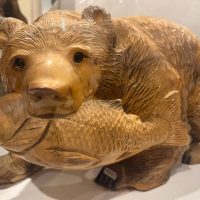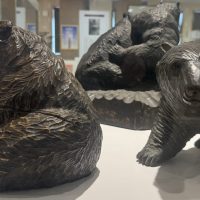Kim-un-kamuy : Ainu God of the Mountains and Bears
Listen
At a glance
| Description | |
|---|---|
| Origin | Ainu Mythology |
| Classification | Gods |
| Family Members | N/A |
| Region | Japan |
| Associated With | Bear, Mountains |
Kim-un-Kamuy
Introduction
Kim-un-kamuy, the revered mountain deity of Ainu mythology, holds one of the most enduring places in the spiritual traditions of the Ainu people of Hokkaido, Sakhalin, and the Kuril Islands. His name translates to “God of the Mountains,” and he is inseparable from the figure of the bear, which the Ainu regard not as a mere animal but as a divine messenger carrying his spirit. Through rituals such as the iomante, where a bear is respectfully raised and ceremonially sent back to the spiritual realm, Kim-un-kamuy becomes a symbol of reciprocity, gratitude, and harmonious coexistence between humans and nature. His presence reflects the Ainu belief that every force of nature possesses a conscious spirit, and that the mountains—home to wild animals and untouched forests—form a sacred bridge between the human world and the divine.
Physical Traits
Traditional accounts describe Kim-un-kamuy in the majestic form of a giant brown bear, embodying both the physical strength of the wilderness and the spiritual force that governs it. His fur is often portrayed as shimmering like the forest canopy, while his eyes glow with the wisdom of the mountains he protects. Some stories describe him shifting between a divine bear shape and a more humanlike presence, reinforcing his ability to communicate with people while still representing the raw essence of the natural world. Unlike aggressive bears that appear in some cautionary Ainu tales, Kim-un-kamuy is benevolent and powerful, a guardian rather than a threat. His appearance in art, woodcarvings, and ceremonial objects has long symbolized protection, abundance, and the sacredness of the land.
Family
In Ainu mythology, Kim-un-kamuy is part of a complex network of divine relationships. One well-known tale describes his celestial wife descending into the human world and failing to return, prompting a crow to inform Kim-un-kamuy of her absence and linking him directly to stories involving humans. He is also associated with other major kamuy such as Kamuy Fuchi, the hearth goddess, and Kina-kamuy, the deity linked to hunting and forest life. These familial and spiritual connections emphasize the deeply interwoven relationship between different gods, people, and natural forces in Ainu cosmology. Rather than existing in isolation, Kim-un-kamuy is part of a living system in which divine beings work together to maintain balance in the world.
Other names
Like many Ainu deities, Kim-un-kamuy is known by multiple names that highlight different aspects of his divine role. Metotush Kamuy emphasizes his association with bears specifically, while Nuparikor Kamuy refers to his dominion over the mountains and their spiritual significance. These regional names reflect how Ainu communities adapted oral traditions to their landscapes, allowing the deity to remain culturally relevant across generations. The variation in names also demonstrates the fluidity of Ainu oral storytelling, where meaning is shaped by geography, community, and lived experience.
Powers and Abilities
Kim-un-kamuy presides over the mountains, wildlife, and the delicate ecological harmony that sustains human life. As the master of bears, he governs their behavior, ensuring that the animals appear when needed and remain plentiful enough to support the community. Bears are seen as his envoys, temporarily taking physical form before returning to the spirit world after respectful rituals. He is also believed to safeguard travelers moving through rugged terrain, protecting them from natural dangers and guiding hunters toward successful expeditions. His powers extend beyond physical protection; he maintains the balance between humans and nature, granting blessings of prosperity, fertility of forests, and overall harmony when properly honored. The Ainu worldview places great emphasis on mutual respect, and Kim-un-kamuy embodies this principle by rewarding gratitude with abundance.
Modern Day Influence
Although the traditional iomante ceremony is rarely practiced today, Kim-un-kamuy remains deeply influential in Ainu cultural revival efforts. Museums, cultural centers, and educational institutions use his stories to teach younger generations about their heritage, emphasizing the spiritual relationship between people and the environment. As modern society faces ecological challenges, Kim-un-kamuy has also become an emblem of conservation and environmental responsibility, inspiring activists, artists, and scholars to draw upon Ainu wisdom. His presence appears in contemporary artwork, literature, and even digital media, where reinterpretations introduce global audiences to Ainu beliefs. Through these expressions, Kim-un-kamuy continues to shape cultural identity, environmental values, and the ongoing preservation of indigenous spirituality.
Related Images
Source
Ashkenazi, M. (2003). Handbook of Japanese Mythology. ABC-CLIO.
Fabulahub. (2025). The Tale of the Ainu Bear God: Kim-un Kamuy and Mountain Spirit. Retrieved from https://fabulahub.com/en/story/ainu-bear-god-kim-un-kamuy-mountain-spirit/sid-2490
Wikipedia contributors. (2011). Ainu religion. Wikipedia. Retrieved from https://en.wikipedia.org/wiki/Ainu_religion
Wikipedia contributors. (2007). Kim-un-kamuy. Wikipedia. Retrieved from https://en.wikipedia.org/wiki/Kim-un-kamuy
Ainu.info. (2009). Religion. Retrieved from https://www.ainu.info/Ainu-Indigenous-rights/Religion.html
IWGIA. (2011). The Indigenous World 2011. International Work Group for Indigenous Affairs. Retrieved from https://iwgia.org/images/publications/0454_THE_INDIGENOUS_ORLD-2011_eb.pdf
Batchelor, J. (2019). The Ainu and Their Gods: Indigenous Mythology of Northern Japan. Tokyo: Kodansha International.
Philippi, D. L. (1979). Songs of Gods, Songs of Humans: The Epic Tradition of the Ainu. Princeton University Press.
Munro, N. (1963). Ainu Creed and Cult. Columbia University Press.
Siddle, R. (1996). The Ainu: Indigenous People of Japan. Routledge.
Ohnuki-Tierney, E. (1995). Illness and Healing among the Sakhalin Ainu: A Symbolic Interpretation. Cambridge University Press
Frequently Asked Questions
Who is Kim-un-kamuy in Ainu mythology?
Kim-un-kamuy is the Ainu god of the mountains and bears, revered as a protector and provider who maintains the balance between humans and nature.
Why are bears sacred to Kim-un-kamuy?
Bears are seen as physical manifestations or messengers of Kim-un-kamuy, making them central to rituals such as the iomante ceremony.
What powers does Kim-un-kamuy have?
He governs wildlife, ensures ecological harmony, protects travelers, and blesses communities with prosperity when honored properly.
What are Kim-un-kamuy’s other names?
He is also known as Metotush Kamuy and Nuparikor Kamuy, reflecting different regional interpretations of his divine role.
How is Kim-un-kamuy viewed today?
He remains a key symbol in Ainu cultural revitalization, environmental awareness, and artistic representation.







